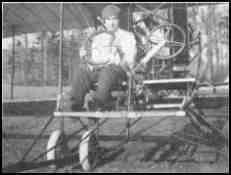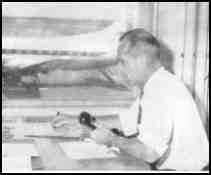

65 H.P. Kirkham Motor, July 4, 1913
-1961 |
 |
 |
||
| Here's Jack Tweed in the first dual control Thomas Brothers biplane at Bath New York, back in the early days of aviation. This machine was powered with a Curtiss engine. | 65 H.P. Kirkham Motor, July 4, 1913 |
 |
||
|
45 years of flying and hobnobbing with aviation. Here he is at his desk at New Haven Airport. |
|
courtesy of Steve Remington - CollectAir |
|
"MR. NEW HAVEN AIRPORT Speaking of Jack and his background, the Journal says in part: "John H. (Jack) Tweed, manager of New Haven Municipal Airport, and one of the nation's veteran fliers, built and cracked up his own plane at age 15 and was the third person in Connecticut to get a pilot's license. In World War I he rose from seaman 2nd class in the Naval Reserve to Lieutenant, Jg, served as instructor, helped build the Naval Air Station at Coco Solo, Panama Canal Zone, and was one of the first to fly the jungle route over the Isthmus of Panama. "After the war he was a test pilot, made barnstorming, exhibition and long distance flights, was the associate of the leading aviators of that time. In 1925 he established Hew Haven's first air service at the New Haven Air Terminal on the eastern shore of New Haven harbor. He had a part in planning and building the Municipal Airport and has been its manager ever since it opened in 1931 except for two and a half years during world War II when the Army took over. "Realizing as a flier the vital importance of safety, and correctly envisioning the great possibilities of air transportation. Jack has concentrated every resource at his command on making New Haven airport one that fliers will recommend. New Haven has been fortunate indeed to have had his services all these years. For all he has done to keep faith and interest in the airport alive he probably deserves to be known as "Mr. New Haven Airport." Back in 1953, the 50th anniversary year of the Wright flight, the New Haven Register ran an entire page on Jack Tweed's own first flight and some of his other experiences. |
|
via email from "Rich", 4-5-04 Jack, aside from being a damn good pilot, was a genuine gentleman. Quiet and unassuming, he lived in Branford, Connecticut, just a short hop away from Tweed. In fact, it was the very next town.. For your information, the army took over the airport (and Yale) for a couple of years, so all civilian planes had to go elsewhere. They took over Yale to house any military personnel, Coast Guard, Navy, Army, etc. The guys stationed at Tweed though, had barracks a minute away from the airport. The place was a real army base in all senses of the word. The army built a beautiful hangar for themselves and when they left, they just abandoned everything they had there to the good of New Haven City. This airport is surrounded by homes, so the possibility of expansion is remote. Waterbury-Oxford airport doesn't have this problem and it's the one to watch. I was at Tweed when a 4 engine navy plane was flown in. It was a surplus job that someone bought for I don't know what. As far as I know, it was the only 4 engine ever to come in. Tweed is still very active with some smaller liners and a lot of freight goes out of there, but I'm afraid expansion isn't for now as the local residents are quite vocal about it. They built their homes there knowing that the airport was there, but nothing much can be done about it now. I don't do any flying myself any more, I'm 78, but I have a good buddy who flew for AA and United. He is retired now, but keeps a Cessna 182 here at Waterbury-Oxford and we go up almost daily. Nice meeting you Ralph. Need more, just give a holler. Happy flying, "Rich" MORE |
|
|
|
|
|
From The Early Birds of Aviation ROSTER, 1996 |
|
If you have any more information on this pioneer aviator please contact me. E-mail to Ralph Cooper |


|